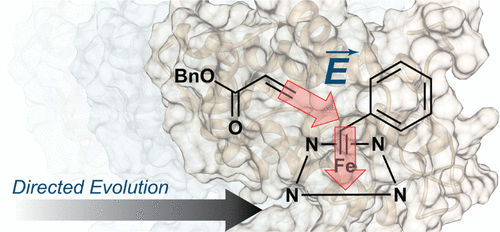Computation across chemistry

Directed evolution has adapted this protein, protoglobin, to catalyze carbene transfer reactions. (Reprinted with permission from Chaturvedi, S.S. et al. J. Am. Chem. Soc. https://doi.org/10.1021/jacs.4c03914. Copyright 2024 American Chemical Society.)
Santiago Vargas is the computational Swiss Army knife of Anastassia Alexandrova’s UCLA research group. Her team studies molecular behavior from large biological structures to small molecules, and Vargas — a Department of Energy Computational Science Graduate Fellowship (DOE CSGF) recipient — contributes with his modeling expertise across that spectrum. “Because of the DOE CSGF,” he says, “my Ph.D. has actually been more guided by the algorithm or the analysis problem rather than becoming an expert in protein design” or another area of chemistry.
For example, Vargas simulated how electric fields move through proteins, solving a long-term tradeoff in modeling biological molecules. Bonds between atoms constantly rotate and vibrate. Until now, however, analyzing the electric field has required taking a snapshot and modeling a single frame of a molecular movie. Using high-throughput algorithms and machine learning, Vargas analyzes volumes of electric fields and how those areas change as they move through a protein’s active site. The work was published this month in the Journal of the American Chemical Society.
When Vargas was four years old, his family immigrated to the United States from Colombia and eventually settled in suburban Massachusetts. During high school at a math and science charter school, his homeroom teacher was a chemist and nurtured Vargas’s interest in science. His computer science teacher remains a mentor and friend. She encouraged him to take a range of courses and helped him develop a love of coding.
As a Harvard University freshman, Vargas participated in an experimental science curriculum that focused on all aspects of becoming a scientist, such as lab skills, computer simulations, biological thinking and high-level math. A diverse, rotating cast of professors taught, each for a month, including several from Hispanic or Latino backgrounds. As Vargas says, that was inspiring and lowered barriers he felt about becoming a scientist. “There are people who look like me and are from similar backgrounds and speak Spanish, who are doing science.”
While taking a course with Mexican American computational chemist Alán Aspuru-Guzik, now at the University of Toronto, Vargas recalls asking a bunch of questions after class. “Within 30 seconds I had a summer internship with him,” Vargas says. That experience laid the foundation for graduate school and his research as a computational chemist.
Besides his graduate research at UCLA, Vargas works with Kristin Persson and DOE CSGF alumnus Sam Blau (2012–2016), both of Lawrence Berkeley National Laboratory, using graph neural networks to study reaction barriers in solid electrolyte interfaces. These materials form on the anodes of lithium-ion solid-state batteries as they operate and can affect their performance over time. Vargas and his colleagues are trying to predict species and reactions present without having to synthesize candidate batteries in the lab.
The collaboration started with Vargas’s 2022 practicum and continues. Vargas contributed by speeding up the Persson lab’s algorithm, BonDNet, and broadening its utility. Most recently, he’s improved BonDNet to compute molecules with a wide range of chemical structures and properties. The team is using the algorithm to simulate potentially hundreds of thousands of molecules that can form in lithium batteries.
Other DOE CSGF connections also have shaped Vargas’s research. He and alumnus Albert Musaelian (2020–2023) completed practicums at Berkeley Lab during the same summer. Since then, Vargas has used the Allegro algorithm, developed by Musaelian and his Harvard colleagues, as part of his ongoing research at UCLA.
Vargas plans to complete his Ph.D. later this year and is aiming for a national lab career. The practicum exposed him to ambitious long-term projects available in that environment. He’s excited about the opportunity to work on the “bigger dreaming, crazier ideas that people want to implement there.”
About the Author
Sarah Webb is science media editor at the Krell Institute. She’s managing editor of DEIXIS: The DOE CSGF Annual and producer-host of the podcast Science in Parallel. She holds a Ph.D. in chemistry, a bachelor’s degree in German and completed a Fulbright fellowship doing organic chemistry research in Germany.





You must be logged in to post a comment.